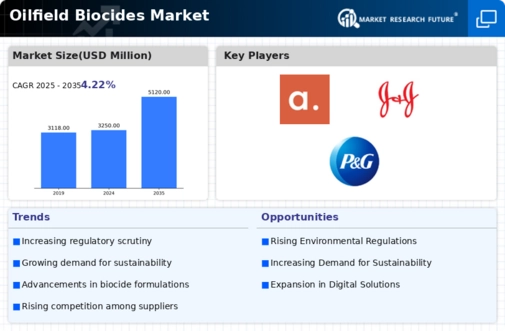Market Share
Oilfield Biocides Market Share Analysis
In the dynamic landscape of the oilfield biocides market, companies employ a variety of strategies to establish their presence and capture market share. One prominent strategy is differentiation, where companies emphasize the unique properties or applications of their biocides to distinguish themselves from competitors. For example, some companies may highlight the superior efficacy, environmental friendliness, or compatibility with specific drilling fluids of their biocides, making them particularly attractive for oil and gas exploration and production operations. By accentuating these distinctive features, companies can attract customers seeking high-quality and reliable biocide solutions, thus carving out a niche within the market.
Cost leadership is another significant strategy, with companies aiming to offer competitive pricing for their oilfield biocides while maintaining profitability. Through efficient manufacturing processes, strategic sourcing of raw materials, and economies of scale, these companies can provide biocides at lower costs compared to their rivals. This approach appeals to cost-conscious oil and gas companies looking to mitigate microbial contamination without overspending on chemical treatments. By positioning themselves as cost-effective options, companies can capture market share among budget-conscious buyers and solidify their position in the market.
Moreover, companies may opt for a niche market strategy, targeting specialized segments or applications within the oilfield biocides market. Instead of competing across the entire market spectrum, they focus their efforts on serving specific customer needs or addressing unique industry requirements. For example, a company might specialize in providing biocides tailored for offshore drilling operations, where factors such as saltwater tolerance, temperature stability, and environmental compliance are crucial. By catering to niche markets, companies can develop expertise, build strong customer relationships, and establish themselves as leaders within their chosen segments.
Branding and marketing play a crucial role in market share positioning strategies within the oilfield biocides market. Building a strong brand identity helps companies differentiate themselves, cultivate customer loyalty, and command premium pricing. Through targeted marketing campaigns, companies can raise awareness about their products, communicate key benefits, and influence consumer perceptions. Whether through industry conferences, technical seminars, or digital advertising, effective branding initiatives enhance visibility and drive demand for oilfield biocides, ultimately contributing to market share expansion.
Strategic partnerships and collaborations also feature prominently in market share positioning strategies. By forming alliances with oilfield service companies, chemical distributors, or research institutions, companies can leverage complementary strengths and resources to gain a competitive edge. Collaborative ventures enable companies to access new markets, enhance product development capabilities, and stay ahead of technological advancements. Through strategic partnerships, companies can expand their market reach, capitalize on growth opportunities, and strengthen their position in the oilfield biocides market.
Innovation serves as a cornerstone of market share positioning strategies in the oilfield biocides market. Companies invest in research and development to introduce new formulations, improve biocide performance, or develop innovative application methods. Whether it's developing biocides with broad-spectrum activity, exploring biodegradable alternatives, or creating customized solutions for specific microbial challenges, innovation drives differentiation and stimulates market growth. Companies that prioritize innovation can capture market share by offering cutting-edge solutions that meet the evolving needs of oil and gas operators and environmental regulations.
Customer experience and service quality are also critical components of market share positioning strategies. Providing excellent technical support, onsite assistance, and timely delivery fosters trust and loyalty among customers. Companies that prioritize customer satisfaction can differentiate themselves from competitors and build long-lasting relationships with clients. Positive experiences lead to repeat business, referrals, and positive word-of-mouth, ultimately contributing to market share expansion and sustained growth.







Leave a Comment